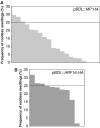Developmental specificity of auxin response by pairs of ARF and Aux/IAA transcriptional regulators
- PMID: 15889151
- PMCID: PMC1142592
- DOI: 10.1038/sj.emboj.7600659
Developmental specificity of auxin response by pairs of ARF and Aux/IAA transcriptional regulators
Abstract
The plant hormone auxin elicits many specific context-dependent developmental responses. Auxin promotes degradation of Aux/IAA proteins that prevent transcription factors of the auxin response factor (ARF) family from regulating auxin-responsive target genes. Aux/IAAs and ARFs are represented by large gene families in Arabidopsis. Here we show that stabilization of BDL/IAA12 or its sister protein IAA13 prevents MP/ARF5-dependent embryonic root formation whereas stabilized SHY2/IAA3 interferes with seedling growth. Although both bdl and shy2-2 proteins inhibited MP/ARF5-dependent reporter gene activation, shy2-2 was much less efficient than bdl to interfere with embryonic root initiation when expressed from the BDL promoter. Similarly, MP was much more efficient than ARF16 in this process. When expressed from the SHY2 promoter, both shy2-2 and bdl inhibited cell elongation and auxin-induced gene expression in the seedling hypocotyl. By contrast, gravitropism and auxin-induced gene expression in the root, which were promoted by functionally redundant NPH4/ARF7 and ARF19 proteins, were inhibited by shy2-2, but not by bdl protein. Our results suggest that auxin signals are converted into specific responses by matching pairs of coexpressed ARF and Aux/IAA proteins.
Figures








References
-
- Alonso JM, Stepanova AN, Leisse TJ, Kim CJ, Chen H, Shinn P, Stevenson DK, Zimmerman J, Barajas P, Cheuk R, Gadrinab C, Heller C, Jeske A, Koesema E, Meyers CC, Parker H, Prednis L, Ansari Y, Choy N, Deen H, Geralt M, Hazari N, Hom E, Karnes M, Mulholland C, Ndubaku R, Schmidt I, Guzman P, Aguilar-Henonin L, Schmid M, Weigel D, Carter DE, Marchand T, Risseeuw E, Brogden D, Zeko A, Crosby WL, Berry CC, Ecker JR (2003) Genome-wide insertional mutagenesis of Arabidopsis thaliana. Science 301: 653–657 - PubMed
-
- Berleth T, Jürgens G (1993) The role of the monopteros gene in organising the basal body region of the Arabidopsis embryo. Development 118: 575–587
-
- Berleth T, Sachs T (2001) Plant morphogenesis: long-distance coordination and local patterning. Curr Opin Plant Biol 4: 57–62 - PubMed
-
- Birnbaum K, Shasha DE, Wang JY, Jung JW, Lambert GM, Galbraith DW, Benfey PN (2003) A gene expression map of the Arabidopsis root. Science 302: 1956–1960 - PubMed
Publication types
MeSH terms
Substances
LinkOut - more resources
Full Text Sources
Molecular Biology Databases

